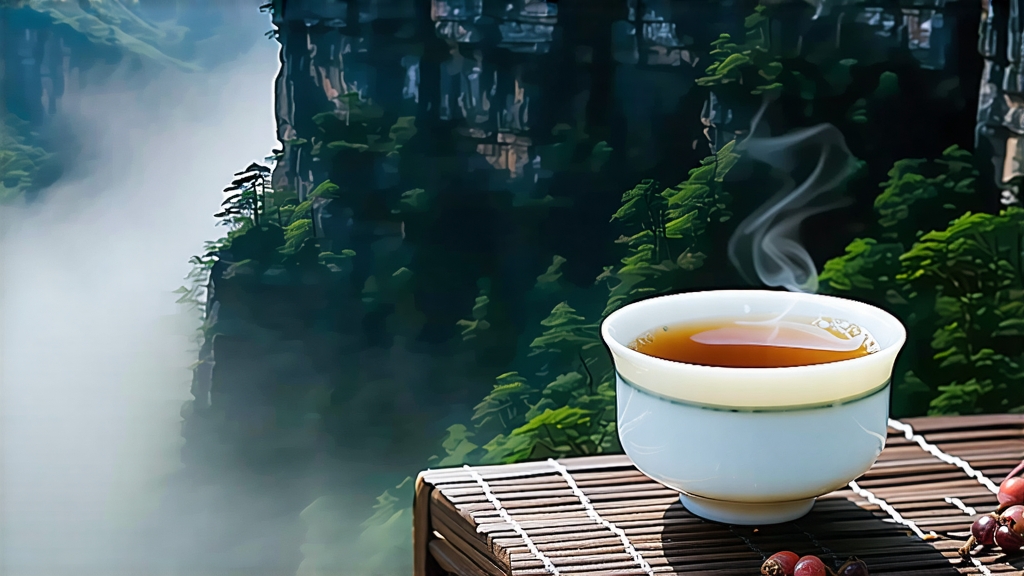
High above the winding Jiuqu Stream, where the Wuyi Mountains thrust their granite shoulders into the humid Fujian sky, grows the most mythic of all oolong teas—Da Hong Pao, literally “Big Red Robe.” Its very name evokes imperial crimson, yet the color refers not to the leaf but to the ceremonial cloaks once draped over six mother bushes to ward off autumn chill. Those six shrubs, still clinging to a narrow fissure in the Niulankeng cliff, have become living antiquities; their spring harvest of less than 400 grams is auctioned for sums that rival vintage Bordeaux. Fortunately for the rest of us, centuries of grafting have spread their genetic song across terraced gardens throughout the Wuyi range, giving the world “purebred” or “xiaozhong” Da Hong Pao, as well as skillful blends that marry the fragrance of cinnamon, the sweetness of peach, and the minerality of weathered stone.
Historical scrolls place the tea in the late Ming dynasty, when a passing scholar, revived by its infusion, supposedly went on to top the imperial exams. In gratitude he petitioned the emperor to bestow the red robes of honor upon the bushes. Whether legend or propaganda, the tale cemented Da Hong Pao’s status as one of the “Five Famous Bushes” (wumingcong) of Wuyi, alongside subtler cousins such as Tie Luo Han and Bai Ji Guan. By the Qing, compressed tribute bricks of Wuyi oolong were traveling the Siberian Tea Road, while Fujian merchants floated leaf down the Min River to the port of Fuzhou, where clipper ships steamed toward London parlors hungry for “Bohea” that was often, in fact, roasted oolong.
Botanically, Da Hong Pao belongs to the Wuyi qi zhong (“local cultivar”) family, a collective of shrubs selected over centuries for their ability to draw minerals from the thin, gravelly soil known as “rock substrate.” This terroir—termed yan wei, or “rock rhyme”—is the signature of authentic cliff tea. When you sip, the liquor seems to echo the landscape: a vibrating note of wet slate, a whisper of orchid, and a finish that Chinese tasters describe as “the returning sweetness of a mountain spring.” The leaf itself is broad, leathery, and irregular, the result of hand-plucking the standard “zhong kai mian” (medium open face) three-leaf set in late April, just before the rains swell the cells and dilute flavor.
Crafting Da Hong Pao is a dialogue between fire and time. The picked leaves are first withered on bamboo trays set in the late-afternoon sun, then moved indoors for “cooling green,” where fans coax moisture from the midrib. Next comes yaoqing—shaking green—the most athletic step: 20-pound batches are rhythmically tossed in rattan drums, bruising the edges so that oxidative enzymes meet air. After two hours the leaf emits a piercing peach-skin aroma; oxidation is arrested at roughly 40 %, the midpoint that gives oolong its bi-colored leaf and dual personality of green freshness and black maturity. The mass is then rolled in hot fabric sacks, twisted into tight strips, and sent to the charcoal room. Here, in low-roofed kilns lined with white ash, a master roaster tends pits of glowing lychee-wood embers. Over 6–10 hours the tea is baked, rested, re-baked, and rested again in cycles that can extend across three lunar months. The goal is to drive out “green” vegetal notes while embedding a warming caramel depth, yet without burying the floral high tones that prove the leaf’s cliff origin.
To brew Da Hong Pao like a Wuyi native, begin with spring water whose TDS hovers around 50 ppm; hard water mutes yan yun, while distilled water flattens body. Pre-heat a 120 ml gaiwan or small Yixing teapot made from zhuni clay, whose iron-rich body amplifies roasted notes. Measure 7 g of leaf—roughly two heaping tablespoons—into the warmed vessel and inhale: the dry aroma should suggest toasted brioche, dried longan, and a faint flint spark. Flash-rinse for one second, discard, then infuse the first steep at 98 °C for 10 seconds. Pour in a thin arc to